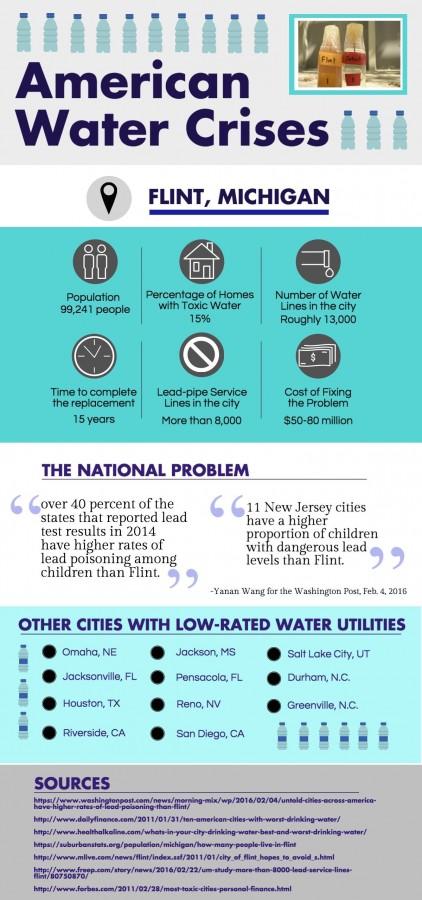How far would you go to save a dollar? For some, penny pinching can be a gratifying way to afford a Snickers bar at the checkout line at Publix. But when it comes to the government, stinginess can lead to the suffering of a whole population.
In April of 2014, the economically plummeting city of Flint, Michigan made a decision to undertake an austerity measure that changed the citywide water source from Lake Huron to the Flint River. The primarily African-American city that is home to almost 100,000 people quickly began experiencing disastrous side effects. Almost everyone realized that something was wrong almost simultaneously. The main clue: all of the water that was delivered through city pipes appeared to be a murky spectrum of reds, browns and yellows.
The discoloration was, and still is, due to water contamination. The Detroit water system that was previously used was everything a good water system should be: the water was transparent, fresh and fit for consumption, all admirable qualities that are not shared by the Flint River, which is rich with sewage, farm runoff and industrial waste—which are not exactly the best flavors for water.
The city tried to clean the water, but they found it to be nearly impossible. Though sewage and waste were able to be easily diverted from the river, the impoverished city still uses toxic lead pipes that are known to be dangerous. This is now a more prominent issue because the Flint River contains high levels of chlorine, which corrodes the lead in the pipes, further degrading the water’s purity.
“Levels of the heavy metal measured in city drinking water at the height of the crisis rose above the threshold for [what is considered] hazardous waste,” a January 2016 Rolling Stone article said.
This hazardous waste, which is found in 15% of Flint homes, has sparked a series of health problems throughout the city. In many of these homes, the lead levels are 900 times above the federal limit. The Detroit Free Press reports that almost 9,000 children tested positive for lead by April of 2015. That is almost 9,000 children that will suffer the neurological and behavioral defects that accompany lead exposure, defects like shortened attention spans and impaired cognitive function that the World Health Organization proclaims to be irreversible.
The issue has drawn national attention in the past months, and efforts to fix it are being made. Well, they’re being talked about—it’s complicated. Even if the water source were switched back to Lake Huron, the pipes’ corrosion would still create more problems and could in turn contaminate the new river.
The Environmental Protection Agency estimates the cost of replacing all the lead service lines in Flint at between $50 and $80 million. Additionally, the project would take 15 years to complete, and there is a chance that the funds would not be sufficient. In a new state budget, the governor of Michigan included $195 million for Flint, which will help replace at least 5,000 old lead lines. Though it will be helpful, it will still leave some lead lines in place. The city has already used $37 million dollars entirely for healthcare and social services.
With no apparent solution, the people of Flint have stopped paying their water bills and no longer have running water available in their homes. Humanitarian efforts by charities and hip-hop stars alike have brought enormous supplies of bottled water to Flint, which residents must rely on for all of their needs until a lasting solution is found.
The water problem serves as more than just a source of suffering for Flint—it exposes an institutional problem of racial and economic inequality across America. Fortune Magazine dubs the phenomenon “environmental racism.” The New York Times explains in February of 2016 that water that serves a third of the population is “not yet covered by clean-water laws that limit levels of toxic pollutants.” Pollution levels are particularly high in poor and minority communities.
“The biggest polluters in the U.S.– factories, warehouse and other facilities using toxic substances—are overwhelmingly located in poor, non-white neighborhoods,” a February 2016 Fortune article said. “Hazardous waste treatment, storage and disposal plants also tend to be built in similar low-income, non-white areas.”
Poor and minority communities often are full of affordable land, and they become attractive sites for such buildings. When companies move to these cities, they prevent the areas from experiencing any economic growth that could have been brought by something more profitable than an auto warehouse. The poor cities remain poor, and the cycle continues.
Durham and Greenville, N.C.; Columbia, S.C.; and Jackson, Miss. are just a few of the cities that have experienced similar problems to those of Flint in recent years.
Just as Flint is not the only city that has fallen victim to a water crisis, lead is not the only chemical that causes health problems in contaminated water. The National Resource Defense Council has also detected high levels of pathogens, haloacetic acids, carcinogens and arsenic, which can lead to general illness, cancer and reproductive problems. These impurities span the entire continent.
“Cancer-causing arsenic is currently present in the drinking water of 22 million Americans at levels…well below a new EPA standard for arsenic,” the National Resource Defense Council said. “Yet there is no safe level of arsenic in drinking water.”
However, the water is not the only toxic substance that plagues America: the lack of understanding about this issue breeds public neglect that is equally toxic to victimized communities. Large-scale reporting on water crises has only occurred in the past four months or so, and it is imperative that this traction not be lost until the issue is resolved. The more attention the problem receives, the more pressured politicians will be to find the funds to resolve it.
Americans deserve the ability to shower or wash their hands without fearing for their health. They are entitled to safety from disease in their own homes. Living in a constant state of concern about water is an unnecessary plight that far too many people currently experience, and the need for change is as clear as the water should be.













